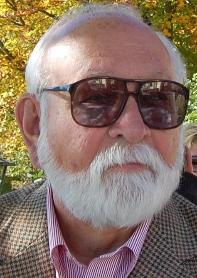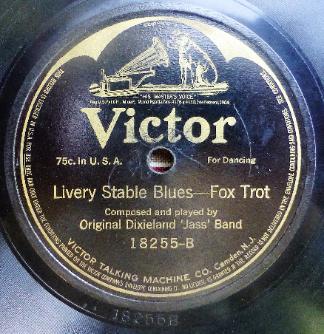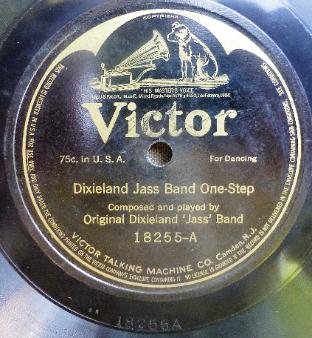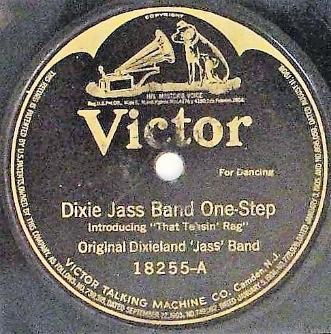
Editor, Webmaster: Phil Cartwright Editor@earlyjas.org
|
| Earlville Association for Ragtime Lovers Yearning for Jazz Advancement and Socialization |
EARLYJAS

Defining moments in jazz history is an inexact science at best. This American art was a
living, breathing part of social history, developing rapidly as it spread. But it took the nascent
recording industry to introduce this new sound to a larger audience. Recognizing the first jazz
recording may be a difficult task, unless the legendary Buddy Bolden cylinder is finally
found.
But the first commercially successful jazz record? Easier to define. Critics and historians
accept RCA Victor #18255 by the Original Dixieland Jass Band (ODJB) as that. Defining
moments in jazz history is an inexact science at best. This American art was a living, breathing
part of social history, developing rapidly as it spread. But it took the nascent recording
industry to introduce this new sound to a larger audience.
Recognizing the first jazz recording may be a difficult task, unless the legendary Buddy
Bolden cylinder is finally found. But the first commercially successful jazz record? Easier to
define. Critics and historians accept RCA Victor #18255 by the Original Dixieland Jass Band
(ODJB) as that milestone. Recorded February 26, 1917, and released in May of that year, with
“Livery Stable Blues” being the first tune done, then “The Original Dixieland Jass Band One-
Step” as the second, it took the country by storm. Approximately 250,000 copies were sold.
The back story: in 1915, Tom Brown and His Band From Dixieland started a gig at Lamb’s
Café in Chicago, brought there at the behest of entertainer Joe Frisco, whose act they backed
up in New Orleans. Their success led to the opening of another New Orleans band in March of
1916 at Schiller’s Café: Stein’s Dixie Jass Band. The personnel were Johnny Stein, dm; Eddie
Edwards, tb; Harry Ragas, p; Alcide Nunez, cl; Nick LaRocca, c.
The band became popular and was offered a better paying gig elsewhere. Stein was the
only member of the band under contract to Schiller’s, so the others left, brought up Tony
Sbarbaro from New Orleans as the drummer, swapped Alcide Nunez to Tom Brown for Larry
Shields, and took the new gig. This group became the Original Dixieland Jass Band. And a
very popular “jass” band, as they were hired by Reisenweber’s Café on Columbus Circle in
NYC, where they opened in January of 1917.
Since the New York area was not only an entertainment center, but the nucleus of the
recording industry, it was only a matter of time until the ODJB wound up in a studio; On
February 26, 1917, they entered the RCA Victor studios, and the rest was – as they say –
history. “Livery Stable Blues” was the first tune recorded; “Dixieland Jass Band One-Step” the
second. Oral evidence is available as to a March release date, but May is correct, based on
evidence found in the RCA files. After the release, controversy surrounded that recording, as
Joe Jordan claimed that the “ODJB One-Step” was actually his “That Teasing Rag.” Agreement
was reached, and the second pressing included the phrase on the label “Introducing That
Teasin’ Rag.”
The fourth edition of Brian Rust’s Jazz Records 1897-1942 lists the first ODJB recording as
being on Columbia A-2297, “Indiana” and “Darktown Strutters’ Ball.” That would have made
it the first recording by the ODJB. However, later research from Rust himself indicates that
these sides were not recorded until May of 1917, and released in September of that year.
Between January and May of 1917, the ODJB also recorded for Aeolian-Vocalion, which
included their first recording of “Tiger Rag.”
Brooke Anderson
living, breathing part of social history, developing rapidly as it spread. But it took the nascent
recording industry to introduce this new sound to a larger audience. Recognizing the first jazz
recording may be a difficult task, unless the legendary Buddy Bolden cylinder is finally
found.
But the first commercially successful jazz record? Easier to define. Critics and historians
accept RCA Victor #18255 by the Original Dixieland Jass Band (ODJB) as that. Defining
moments in jazz history is an inexact science at best. This American art was a living, breathing
part of social history, developing rapidly as it spread. But it took the nascent recording
industry to introduce this new sound to a larger audience.
Recognizing the first jazz recording may be a difficult task, unless the legendary Buddy
Bolden cylinder is finally found. But the first commercially successful jazz record? Easier to
define. Critics and historians accept RCA Victor #18255 by the Original Dixieland Jass Band
(ODJB) as that milestone. Recorded February 26, 1917, and released in May of that year, with
“Livery Stable Blues” being the first tune done, then “The Original Dixieland Jass Band One-
Step” as the second, it took the country by storm. Approximately 250,000 copies were sold.
The back story: in 1915, Tom Brown and His Band From Dixieland started a gig at Lamb’s
Café in Chicago, brought there at the behest of entertainer Joe Frisco, whose act they backed
up in New Orleans. Their success led to the opening of another New Orleans band in March of
1916 at Schiller’s Café: Stein’s Dixie Jass Band. The personnel were Johnny Stein, dm; Eddie
Edwards, tb; Harry Ragas, p; Alcide Nunez, cl; Nick LaRocca, c.
The band became popular and was offered a better paying gig elsewhere. Stein was the
only member of the band under contract to Schiller’s, so the others left, brought up Tony
Sbarbaro from New Orleans as the drummer, swapped Alcide Nunez to Tom Brown for Larry
Shields, and took the new gig. This group became the Original Dixieland Jass Band. And a
very popular “jass” band, as they were hired by Reisenweber’s Café on Columbus Circle in
NYC, where they opened in January of 1917.
Since the New York area was not only an entertainment center, but the nucleus of the
recording industry, it was only a matter of time until the ODJB wound up in a studio; On
February 26, 1917, they entered the RCA Victor studios, and the rest was – as they say –
history. “Livery Stable Blues” was the first tune recorded; “Dixieland Jass Band One-Step” the
second. Oral evidence is available as to a March release date, but May is correct, based on
evidence found in the RCA files. After the release, controversy surrounded that recording, as
Joe Jordan claimed that the “ODJB One-Step” was actually his “That Teasing Rag.” Agreement
was reached, and the second pressing included the phrase on the label “Introducing That
Teasin’ Rag.”
The fourth edition of Brian Rust’s Jazz Records 1897-1942 lists the first ODJB recording as
being on Columbia A-2297, “Indiana” and “Darktown Strutters’ Ball.” That would have made
it the first recording by the ODJB. However, later research from Rust himself indicates that
these sides were not recorded until May of 1917, and released in September of that year.
Between January and May of 1917, the ODJB also recorded for Aeolian-Vocalion, which
included their first recording of “Tiger Rag.”
Brooke Anderson


